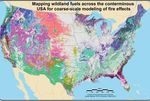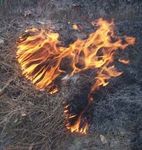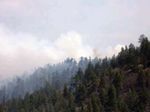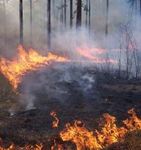Consume 3.0-A Software Tool for Computing Fuel Consumption
←
→
Page content transcription
If your browser does not render page correctly, please read the page content below
Fuel, heat and oxygen—though its nature is always the same, fire behaves differently
all the time. Consume 3.0, a software tool, calculates the amount of fuel consumption in different
fire scenarios, enabling managers to plan fire activities to further land management goals.
Consume 3.0—A Software Tool
for Computing Fuel Consumption
Summary
Knowing when, where and how fire should be applied is critical for land managers planning to use fire prescriptively for
land management goals, or allowing fires ignited naturally to burn. Myriad variables need to be taken into consideration
to determine how fire will consume different fuels. Consume, version 3.0 is a user-friendly software that incorporates the
Fuel Characteristic Classification System (FCCS) to predict fuel consumption, pollutant emissions, and heat release.
A flexible tool, Consume 3.0 makes these calculations based on fuel loadings, fuel moisture and other environmental
factors.
Fire Science Brief Issue 55 June 2009 Page 1 www.firescience.govKey Findings
• Consume 3.0 resolves differences in fuel consumption between the flaming phase of consumption and the smoldering
phase that usually causes the majority of wildfire emissions.
• The 3.0 version of Consume includes consumption models for fuel categories in additional fuel types such as black
and white spruce/hardwoods; longleaf and loblolly pine; ponderosa pine; grasslands; and sagebrush.
• Consume 3.0 works within the Microsoft Windows operating system. However, calculations are handled in a Java-
based engine and can be run separately in batch mode detached from the Windows environment. A wide variety of
operating systems, such as Macintosh, Unix and Linux can thus be used.
Introduction Most Americans learn in elementary school about
A breeze is blowing, the sky turns a red haze, and a the fire triangle. Remove one arm of the triangle, heat for
plume of ascending white offers a warning. Homeowner or instance, and you take away fire. Or deprive the three-sided
hiker, the observer thinks: everything is about to change. model of oxygen, and you suffocate fire. And everyone
Where I stand, will this fire roar like an industrial engine knows that fire needs something to feed on. But beyond
burning through everything in its path? Will this fire our elementary school introduction, many Americans who
produce a pall of smoke that will impact the health of the do not live or work close to the land (and that’s almost
neighboring community or reduce the visibility for tourists? everybody), aren’t aware of the variables that can affect
Though its character is always the same—made of heat, fuel fire. How hot does chaparral burn? How fast does a grass
and oxygen—fire burns fuels differently, changing the way fire spread? How much smoke does a flaming fire produce?
it impacts the environment. The hiker, the homeowner, the Or a smoldering one?
fire crew, the land manager assess: how will this fire change
the landscape I am seeing today? How will the smoke
impact me today?
Smoke from the 2007 Southern California fires. Credit:
NASA/MODIS Rapid Response.
With so many ecosystems in the world, and seasons,
and shifting weather, land managers face challenges when
trying to plan to use fire—whether set prescriptively or
ignited naturally and allowed to burn—to help restore
healthier wildland conditions. Roger Ottmar, Research
Forester with the Fire and Environmental Research
Applications Team of the Pacific Northwest Research
Station considered fire science’s computing tools. Where
could improvements be made?
Sense and computability
It all started in the early 1980s, when FERA—the
Fire and Environmental Resource Application Group of
the Pacific Northwest Research Station—began developing
models that could calculate fuel consumption and emissions
for prescribed burns in the Pacific Northwest. That first
iteration was Consume 1.0, a software tool that calculated
consumption from data researchers had collected during
Woody fuel consumption was predicted by category—
prescribed burns.
whether one-hour fuels such as grasses, or larger diameter
fuels that take longer to burn. Litter and duff consumption In the 1990s, FERA expanded the software’s
was predicted by looking at the pre-burn loading, and the capability. The new version could tell the application user
amount the forest floor materials were reduced after a the amount of fuel consumption by combustion stage for
modeled burn. fuel types outside of the Pacific Northwest, and by different
Fire Science Brief Issue 55 June 2009 Page 2 www.firescience.govconfigurations of fuels. By the time version 2.1 was ready, it in Alaska; longleaf pine and sandhill-hardwood pine
also allowed input of factors contributing to emissions, and transition in the South; and marsh grass, and tall grass
therefore pollutants, providing a greater level of flexibility. prairie in the South and Midwest. “The broad array of fuel
FERA also began developing a new system characteristics in our selected fuel types required a flexible
that classified fuels by their characteristics: the Fuel study design that allowed tailoring of consumption measures
Characteristic Classification System (FCCS). By using for each fuel type and their associated variables,” Ottmar
this system, a manager could build fuelbeds with different explains. To do this, the scientists conducted an extensive
fuelbed characertistics and account for fuel loadings, review of the literature on potential fuel consumption
whether the fuels were piled, not piled, or naturally placed, methods, in addition to inventorying and burning 106 sites
to run fuel consumption and emission calculations. When for their project.
Ottmar and his team set out to enhance the Consume The team also took another detailed look at 32 sites
software, they strove to enable it to predict fuel consumption that were burned prior to their project, and they incorporated
and smoke emissions for all wildland fuel types in the this information into the development of fuel consumption
United States using the FCCS as the fuelbed engine. models for the 3.0 version of Consume they were building.
Engrossed thus, the scientists saw Consume 3.0 begin to
take shape.
Developed by FERA, the FCCS, now linked to Consume Scientist conducting field measurements.
3.0, classifies fuels by their characteristics. By looking at
fuel maps for different areas, managers can see the type To a choice, wisely
of combustibles they will have to work with when planning
to use fire. Credit: USDA Forest Service, Pacific Northwest
Ottmar and the team had assembled the raw material
Research Station. of data they would use to craft the updated software.
The scientists chose user-friendly and widely accessible
Calling forth the sources operating systems as the framework in which to run
If two heads are better than one, then most certainly Consume 3.0. With familiarity of Microsoft Windows
what is contained in the knowledge and experience of applications, a user can enlist Consume 3.0 to predict the
several hundred fire and fuel managers is a bonanza. By amount of fuel consumption, emissions, and heat release for
doing what the wise everywhere do, Ottmar and his team a particular fuel scenario, such as a logged area, or a place
went to the source for the best information on which fuel where debris has been piled, or a stand where natural fuel
types face increased wildland fire risk and for those in which conditions can be found. The software will factor in weather
current fuel consumption data was limited. conditions, the amount of fuels on site and the amount of
By surveying professionals at national and regional moisture in those fuels, and many other variables to produce
workshops, and fire effects, smoke management and a modeled result.
burn boss national training classes, the team was able to For the land manager
For the land manager
determine which fuelbed types should be a priority for wanting to employ fire as a wanting to employ fire as
this study. Through interviews with personnel of many restorative tool while also a restorative tool while
federal agencies, the team selected five fuelbed types for wishing to minimize impacts also wishing to minimize
further study: Sage in the Intermountain, Pacific Northwest to public health and other impacts to public health
and Rockies, with west coast and interior chaparral and resources, the simulations and other resources, the
oak brush in the Southwest and Rockies and palmetto- are invaluable. Results from simulations are invaluable.
galberry in the Southeast; ponderosa pine and fir in the Consume 3.0 can tell managers
Intermountain, Pacific Northwest, Rockies and Southwest; the best time and place to carry out burns to meet a
black spruce, white spruce, and birch and aspen hardwoods number of their critical objectives, Ottmar explains, “…if
Fire Science Brief Issue 55 June 2009 Page 3 www.firescience.gova management objective for a harvested unit with logging
slash was to retain an average duff depth of two inches on
the unit, the manager could use Consume to determine the
1000-hour fuel moisture at which a burn could take place
and meet the objective. Another management objective
might be to produce less than 100 tons of particulate
matter not exceeding 2.5 micrometers in diameter (PM2.5)
from a prescribed burn. By adjusting fuel and weather
input variables, the manager could determine whether the
prescribed burn will meet the 100-ton objective.”
Consume 3.0 allows users to input ever greater detail to
more accurately model real world conditions. Credit: Final
Report JFSP Project Number 98-1-9-06.
Open for reinterpretation
Consume 3.0 is available for downloading online,
as well as on compact disk. The scientists explain that
as knowledge changes, so too will Consume. New shrub
algorithms that are developed will be incorporated into
Consume, and updates will also occur as the FCCS adds
Prescribed burning.
information on additional fuel beds. Since little fuel
consumption work has been completed in the northeast and
Because the FCCS was developed to work with Midwestern hardwoods, for example, they see opportunities
Consume, managers have at their disposal an array of fuel for new data improving Consume’s abilities which the Joint
loading values from this national fuelbed reference library. Fire Science Program recently funded. Other new features
“With its built-in link to the FCCS, Consume can be used deliver more subtlety related to the products of combustion.
for most forest, shrub and grasslands in North America
and may be applicable to other areas of the world,” Ottmar
offers. The scientists recognized that some users would need
Consume to run in batch mode as part of a larger modeling
effort. To that end, the team developed the software so
that its Java-based calculator engine can be run outside
of the Windows environment. The calculating function is
compatible with a wide variety of operating systems, such
as Macintosh, Unix and Linux. Output files can be imported
into other models, the team explains, and analyzed in
spreadsheet or statistical software.
The real world is more complex than software tools often
allow. Consume 3.0 enables users to model multiple units
for one project, multiple fuelbed types for each unit, multiple
fuel layers for each fuelbed, and emissions and consumption
by combustion stage for each of those layers. Credit: Final
Report JFSP Project Number 98-1-9-06.
Fire consumption is based on complex chemistry
involving the type of fuel, and how efficiently it can
burn. Wet wood smokes and wood too dry burns very
fast with little smoke. Using a tool that can accurately
model these drastic variations is critical for managers
Wildland fire. making decisions, as visibility and healthful air quality
Fire Science Brief Issue 55 June 2009 Page 4 www.firescience.govare often major concerns for communities that will be
affected by fire. Consume 3.0 resolves differences in fuel Management Implications
consumption between the flaming phase of consumption
and the smoldering phase that usually causes the majority of • Managers can use Consume 3.0 to help with
wildfire emissions. decisions as they plan for prescribed fire or
This version of the software also includes the ability wildland fire use because the software predicts fuel
to more accurately model real-world conditions rather than consumption, pollutant emissions, and heat release
restricting the software data to homogenous characteristics. based on fuel loadings, fuel moisture, and other
Users can now program multiple units within one project, environmental factors.
as well as input multiple fuelbed types within each unit. • With the information from Consume 3.0’s models,
Adding to further flexibility and detail, the software can managers can plan when and where to conduct fire
accept data for each fuelbed broken down by fuelbed layer. use for land management goals.
And going down to ever smaller detail, the software has the
• Managers will find Consume 3.0 a user-friendly
ability to look at emissions and consumption by combustion
application that works with their Microsoft Windows
stage for each fuelbed layer. Through this virtual window on
knowledge and skills. Because Consume 3.0
the world, the manager, the application user, the planner can
imports data from the FCCS, managers will find the
simulate fuel consumption, smoke effects, and heat release.
outputs have calculated the array of factors with
different fuel types, fuel conditions, weather factors,
consumption and emission by combustion phase
and by fuelbed category—all formatted to feed other
models and produce workable reports.
Ottmar, Roger D. and David V. Sandberg. 2003. Predicting
forest floor consumption from wildland fire in
boreal forests of Alaska — preliminary results. In:
Galley, K.E.M.; Klinger, R.C.; Sugihara, N.G., eds.
Proceedings from Fire Conference 2000: The First
National Congress on Fire Ecology, Prevention, and
Forest floor fire. Management. Miscellaneous Publication No. 13. 218-
224.
Further Information: Ottmar, Roger D., Robert E. Vihnanek, Clinton S. Wright,
and J. Kevin Hiers. 2003. Modification and validation
Publications and Web Resources
of fuel consumption models for use in longleaf pine
Ottmar, Roger D., Susan J. Prichard, Robert E. Vihnanek, types of the Southeast. Extended abstract. In: Kush,
and David V. Sandberg. 2006. Modification and John S., comp. Longleaf pine: A southern legacy
validation of fuel consumption models for shrub and rising from the ashes, proceedings of the Fourth
forested lands in the Southwest, Pacific Northwest, Longleaf Alliance Regional Conference. Longleaf
Rockies, Midwest, Southeast, and Alaska. JFSP Final Alliance Report No. 6.
Report 98-1-9-06. Online at:
http://www.fs.fed.us/pnw/fera/research/smoke/ Ottmar, Roger .D., David V. Sandberg, and A. Bluhm.
Consume/Consume30_users_guide.pdf 2003. Biomass consumption and carbon pools. Poster.
In: Galley, K.E.M., Klinger, R.C.; Sugihara, N.G.
Ottmar, Roger D. and Susan J. Prichard. 2008. Consume (eds) Proceedings of Fire Ecology, Prevention, and
website. Online at: http://www.fs.fed.us/pnw/fera/ Management. Misc. Pub. 13. Tallahassee, FL: Tall
research/smoke/Consume/index.shtml Timbers Research Station.
Fire Science Brief Issue 55 June 2009 Page 5 www.firescience.govScientist Profile
Roger Ottmar is a Research Forester with the Fire and An Interagency
Environmental Research Applications Team, Pacific Research, Development,
Northwest Research Station at the Pacific Wildland Fire
Sciences Laboratory located in Seattle, Washington.
and Applications
Roger has been involved with fuels, fire, and smoke Partnership
related research for over 30 years.
Roger Ottmar can be reached at:
USDA Forest Service Pacific Northwest Research Station
Pacific Wildland Fire Sciences Laboratory
400 North 34th Street, Suite 201
Seattle, WA 98103
Phone: 206-732-7826
Email: rottmar@fs.fed.us
Collaborators
USDA Forest Service, Regions 1, 3, 6, 8, 9
Bureau of Land Management
U.S. Fish and Wildlife Service
JFSP Fire Science Brief
National Park Service is published monthly.
Our goal is to help managers
U.S. Department of Defense—Army find and use the best available
fire science information.
U.S. Department of Defense—Air Force
Learn more about the
Joint Fire Science Program at
www.firescience.gov
John Cissel
Program Manager
208-387-5349
National Interagency Fire Center
3833 S. Development Ave.
Boise, ID 83705-5354
Tim Swedberg
Communication Director
Timothy_Swedberg@nifc.blm.gov
208-387-5865
Writer
Lisa-Natalie Anjozian
lisa@toeachhisownmedia.com
Design and Layout
RED, Inc. Communications
red@redinc.com
208-528-0051
Results presented in JFSP Final Reports may not have been peer- The mention of company names,
reviewed and should be interpreted as tentative until published in a peer- trade names, or commercial products
does not constitute endorsement
reviewed source.
or recommendation for use
by the federal government.
The information in this Brief is written from JFSP Project Number
98-1-9-06, which is available at www.firescience.gov.
Fire Science Brief Issue 55 June 2009 Page 6 www.firescience.govYou can also read



























































